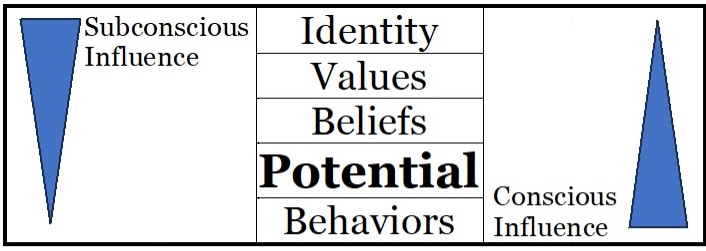Mind Layers: Potential

Most of the mind layers have labels which are fairly easy to understand. The concept of Potential, though, is not immediately obvious. What do we mean by Potential?
Potential may refer to any or all of the following:
- Our perception of what we can learn or do
- Our awareness of different options when making a decision
- Our willingness to try different solutions when faced with a problem
One of the big obstacles people frequently face is the idea of their own potential. We often can't see what we're capable of, simply because we've never done it. Yet we all have the ability to learn more than we currently know, develop skills we don't currently have, and gain expertise we don't currently have. Better yet, it's almost a perpetual motion machine. The more we expand our potential, the more our potential expands. All we have to do is believe it's possible.
Sadly, many of us don't believe that at all. We're convinced we've hit our limit, we think we are as much as we can be, or that we can't learn something new. That can become very specific, such as "I'm no good at math" or "I just can't do computers" or "I can't spell" or "I've never been any good at sports" or whatever. We tell ourselves these things even though we've already learned much more complicated skills.
The good news is, people are fully capable of learning new things, if they only give themselves permission to do so. Hypnosis, NLP and/or coaching can help get folks past any sort of obstacles about learning new skills, so that we can expand our abilities and tap into a higher quality of life. Expanded potential also gives us access to a wider range of options, even though those options may not be at all related to what we've done before. For instance, after we accomplish one big project, we can use that as a confidence-booster when we're getting ready to tackle our next big project, even when those two projects have nothing else in common. So, how do we expand our potential? First, we need to figure out if we have any preconceived limits on our Potential, so that we can push beyond them. Let's take a closer look.
How Our Potential Reveals Itself
As we have seen with other layers of the mind, sometimes the Potential layer shows itself most clearly in the things we say during normal conversation. Here are some of the statements we make, which come from the Potential layer of the mind:
"I can .........”
"I am able to........."
"I have the ability......"
"It’s possible.........."
"I learn.........."
"I realize.........."
"I increase.........."
"I expand........."
As we read through the above list, keep in mind several really important elements:
- You'll notice that most of the above are based on either current or future activities. That is in part because the Potential layer of the mind is within the consciousness.
- But also recall that the Potential is the second-lowest mind layer, which means it is based on all of a person's identities, values and beliefs.
- Those, in turn, are mostly based on what has happened in the past. So one way to define Potential is that our future is based on our past experiences, and the identities, values and beliefs we have based on those experiences.
- The potential layer is not fixed. Instead, it is a perception which changes over time, and with different circumstances or context. Sometimes it changes over very short intervals, even hour to hour. It can even change based on whether we're rested or tired, calm or frightened, happy or angry, hungry or full. It is extremely malleable.
All the above elements figure into a person's current perception of his or her potential. Some days a person feels ready to reach for the stars. Other days, it's tough just to get out of bed. But if you take anything at all from this page, remember this: people consistently underestimate their own potential. That's because a combination of limiting beliefs, values and identities are telling us that we can't, even when others know that we can.
How Perceived Potential Shapes Our Lives
When our current perceived potential tells us that "we can", that gives us permission to move forward and try new things. That doesn't mean we'll never make mistakes; of course we will. Mistakes are a natural (and even desirable) part of moving into new activities, working towards new goals, or learning new skills. Our mistakes teach us valuable lessons that we wouldn't learn otherwise. But when we believe "we can", and when our values and identities support that expansion into new things, we continue to move forward through any obstacles. The more we learn, the more our potential expands, and each new step prepares us for further steps.
Interestingly, when we're young, we intuitively know that we've got amazing potential. Children are constantly trying new things, and they aren't so bothered as adults when they make mistakes. Consider when a child is learning to walk. They fall over countless times, but they just keep getting up and trying again. Or when a child is learning to speak, learning to write, learning to draw, learning math, or any other skill. They make mistakes all day long and keep going. That's because if a child is raised in a supportive environment, their perceived potential is almost limitless. So they keep expanding their horizons and stacking up lessons and skills one after the other. We can do that too, if we give ourselves permission to try.
How Perceived Potential Can Create Problems
Like all the other mind layers, our Potential is formed in childhood. As we've seen above, a child in a healthy supportive environment will blossom. So what situations can damage Potential? Consider the following examples:
- When a child is raised in an unhealthy environment, that child's perceived potential can start to falter.
- If the child is overly criticized, he or she will start to hesitate when trying new things.
- If that child is repeatedly ridiculed, chastised, and/or told poisonous things by parents, family members, teachers or other adult figures, he or she will lose confidence in what he or she can do, and his or her perceived potential will start to drop.
- On the other end of the spectrum, sometimes a child is encouraged or even pressured to advance quickly. The child may seem enthusiastic about making the effort, because he or she wants to please and/or wants the affirmation that comes from success. But pushing too hard too quickly can backfire, resulting in a child either losing confidence, and/or losing motivation. If all that pressure resulted in a lot of mistakes made, the child can learn that potential = stress, and less potential would result in less stress.
Any of the above scenarios can seriously damage a child's potential, both in that moment, and as the child grows older. In fact, that sabotage can last for the rest of that individual's life. Unfortunately, many of us grew up in conditions like the above, and our perceived potential took a hit. The good news is, we don't have to live with a damaged sense of potential our whole lives. We can make healthy changes, and suddenly open up all sorts of new opportunities for ourselves.
Change Potential, Change Our Lives
Recall that our potential is the second-lowest mind layer, so most of it is based on our beliefs, values and identities. That means the fastest, easiest way to improve our perceived potential, is to make improvements to those other layers. Also recall that our perceived potential lay within the conscious mind, so we have 24/7 access to it. So, how do we change it? There are several ways we can make those changes.
First, we can consider the goals we have, and create vision boards or affirmations for achieving those goals. If our other layers are in alignment, this technique is often sufficient.
But sometimes we have trouble picturing ourselves as being able to achieve a goal. We'll speak in terms of "I can't" or "I mustn't" or "I shouldn't" or "that's just not who I am." Those are all big red flags that we have limiting beliefs, values and/or identities which are getting in the way.
If we don't seem to have any beliefs, values or identities which get in the way, Option 1 above may be all we need. However, if we have determined that we're impacted by Option 2, we can learn and perform a variety of NLP techniques to clear out those limiting beliefs, values and identities. If that option seems a bit much, we can also work with a certified success coach or NLP practitioner, and address whatever may be holding us back. Either option will not only boost our perceived and actual potential to accomplish our near-term goals, but also provide long-term improvements.
If you would like help with rising above some limiting belief, value or identity issues, contact me for an initial consultation. We can discuss your goals, your obstacles, and your options for working through them.
|
Shopping Cart |
|
Contact Me For Help Reaching Your Goals

When you're ready to move forward, push through obstacles and make real progress towards your goals, Contact Me today.
New Products and Services Request Form
Do you have a product or service request that you don't already see listed here? I'd love to hear your ideas! Please feel free to either Contact Me or fill out my new Product and Service Request Form.
Thanks for your suggestions!
